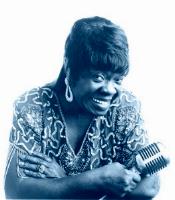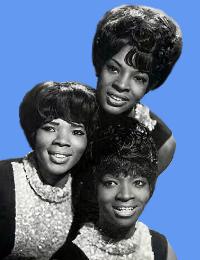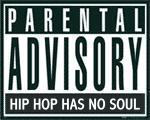Am 28. September 1935 wurde auf einer Farm bei Memphis (Shelby County), Tenn., Cora "Koko" Walton als die jüngste Tochter von Willie und Annie Mae Walton geboren.
I come from a poor family, erzählt sie, a very poor family. I was raised up on what they call a sharecropper’s farm ... My father, my mother were sharecroppers, if you know what that means. They were people that lived in the country on a cotton farm and this is what we did as us kids grew up. We grew up workin' in the cotton field, pickin' cotton, choppin' cotton, or gardening-hogs, cows, chickens, and all this kind of carryin' on. But it was a good life, growin' up in the country, it was one that I enjoyed, one that I always remember and refer to. In a lot of ways I miss that. But we was a poor family. We was a family that, you know, my father and mother, they didn't have nothin' ... But we was in country, we wasn't in the city. Where I lived we didn't even have streets. We had a path go across the field from my house to somebody else's house, and a railroad track, and a road. Yeah, we had roads that a car or a mule and wagon would go across. You know, it wasn't no cars or traffic passing. ... If we looked out our window, we didn't see nothin' but some chickens runnin' around in the yard, maybe a snake passin' by.
Eine Waise im Alter von 11, wuchs sie in diesen ärmlichen Verhältnissen in Memphis auf. Nach eigenen Angaben arbeitete sie selbst in den Baumwollfeldern, bis sie 18 Jahre alt war:
But as far back as I can remember, I think I was somewhere like eight or ten years old when I first started workin' in the field and everything. And not only that, when you too little or too young to work in the field so far as pickin' or choppin' cotton, then you be a water boy or water girl. You go draw a bucket of water and take it to the ones that is out there workin'. ... Sometimes we'd be goin' up and down a row of cotton, choppin' or pickin', either one - me and my brothers and sisters and all, and sometimes some of the other kids that lived around, they might be out there with us.
Im Alter von 18 (nicht erst mit 21, wie sie später manchmal sagte) entfloh sie aber ihrem bisherigen Leben und ging 1953 mit ihrem späteren (und sechs Jahre älteren) Mann Robert "Pops" Taylor nach Chicago. (I came to Chicago when I was 18. My husband and I came on a Greyhound bus with nothing more than 35 cents and a box of Ritz crackers). Noch in den 50er Jahren begann sie, in den Blueskneipen von Chicagos South Side aufzutreten, war jedoch, wenn überhaupt, nur den Eingeweihten bekannt.

Nach eigener Aussage hatte sie bereits in Memphis zu singen begonnen, zuerst mit ihren fünf älteren Brüdern und Schwestern:
I started singing as a child with my brothers and sisters out behind our house. We listened and sang gospel music but us kids all loved the blues. We used to listen to B.B. King's Radio Show and Rufus Thomas’ Radio Show and learn and sing all the songs we heard. Memphis Minnie's 'Black Rat Blues' was one of my very first favorites.
Mit 15 sang sie im örtlichen Bapistenchor - (The church that I attended was just a little old country Baptist church. That's all it was. It wasn't nothin' beautiful. It wasn't nothin' fancy. It wasn't nothin' pretty. And it was nobody there that was dressed up in expensive, fancy clothes to show off) -, privat aber liebte sie die Songs von Bessie Smith (1894-1937), Memphis Minnie (eig. Lizzie Douglas, 1897-1973) und Big Mama Thornton (eig. Willie Mae Thornton, 1926-1984). Obwohl sie später niemals professionell ein Instrument benutzte, lernte sie Gitarre spielen; ihre Geschwister bauten sich schon in Kindertagen eigene Instrumente.
In Chicago fand sie zunächst Arbeit als Putzfrau bei einer reichen Familie im Norden der Stadt und verdiente damit $ 5 am Tag. (I spent a lot of time on my knees and I don't mean praying. I mean scrubbing folks' floors). Außerdem versuchte sie, ihre Schulausbildung zu Ende zu bringen, die sie in Memphis nach dem sechsten Jahr beendet hatte; ihr Mann arbeitete währenddessen in einem Schlachthaus und als Lastwagenfahrer. An den Wochenenden besuchte sie die Blueskneipen und trat schließlich auch in ihnen auf, nachdem ihre gewaltige Stimme Eindruck gemacht hatte. Die ersten beiden Songs, die sie jemals auf einer Bühne und vor Publikum sang, waren I Idolize You (ein Tina Turner Song von 1960) und Make Me Feel Good, Kiddio von Brook Benton (eig. eigentlich Benjamin Franklin Peay, 1931-1988). Der erste Song, den sie im Jahr 1964 selbst schrieb, hieß What Kind of Man Is This? und war ihrem Ehemann Pops gewidmet. Trotzdem wurde sie später dafür kritisiert, daß sie in ihren Songs kaum persönliche Erfahrungen schildert und daß ihr Privatleben in ihren Liedern kaum Widerhall findet.
In den Blueskneipen von Chicago trat sie zusammen mit J. B. Lenoir (1929-1967) und Hound Dog Taylor (eig. Theodore Roosevelt Taylor, 1917-1975) auf, die beide selbst einigen Ruhm als Bluesmusiker erlangen sollten:
There was a guy by the name of J. B. Lenoir. I used to sit in with him and go around to different places that he'd go, and sing with him. Then, there was another guy by the name of Magic Sam. I'd sit in with him a lot, too. Then Hound Dog Taylor. And Hound Dog Taylor, at that time he wasn't doin' no more than me.
1962 wurde die Blues-Legende Wille Dixon (1915-1992) auf sie aufmerksam, als sie an einem Abend mit der Band von Howlin' Wolf auf der Bühne stand. Dixon soll zu ihr gesagt haben: My God, I never heard a woman sing the blues like you sing the blues. There are lots of men singing the blues today, but not enough women. That's what the world needs today, a woman with a voice like yours to sing the blues.
Unter dem Namen Koko Taylor, unter dem sie schließlich berühmt werden sollte, erhielt sie deshalb im Jahr 1965 bei Chess Records in Chicago ihren ersten ordentlichen Plattenvertrag, nachdem sie schon seit 1963 auf Singles von anderen Labels (Checker/Chess, Spivey, USA) zu hören gewesen war und nachdem sie in diesem Jahr ihre erste eigene Aufnahme mit dem Song Honky Tonky erlebt hatte: Next thing I know I have a recording contract with Chess. I didn't even know what a recording contract was, let alone a recording studio. But that's what happened. Ihre lebenslange musikalische Beziehung zu Howlin' Wolf (eig. Chester Arthur Burnett, 1910-1976) wurde 1996 anerkannt, als sie den Howlin' Wolf Award verliehen bekam.
Der Ursprung ihres Kosenamens "Koko" - manchmal auch widersinnig als "KoKo" geschrieben - ist unklar. Einige behaupten, er gehe auf eine kindliche Aussprache ihre Namens "Cora" zurück, während andere sagen, "Koko" verdanke sich ihrem großen Appetit auf Schokolade. Jedenfalls besaß sie diesen Kosenamen bereits, als sie in den 60ern als "Koko Taylor" bekannt wurde.
Kokos erster großer Hit, Wang Dang Doodle von Willie Dixon, wurde zwar nicht eigens für sie geschrieben, wie man manchmal lesen kann, sollte aber zeitlebens eine ihrer "Erkennungsmelodien" bleiben. Der Song wurde im Jahr 1959 zunächst von Howlin' Wolf aufgenommen und populär gemacht; später hatten ihn Savoy Brown, die Pointer Sisters, Rufus Thomas (Do the Funky Chicken!) und Marva Wright in ihrem Repertoire. Koko nahm diesen Song im Dezember 1965 auf.
Der Ruhm von Koko Taylor wuchs langsam aber stetig in den 60er und 70er Jahren, bis sie sich den Ehrentitel "The Queen Of Chicago Blues" erarbeitet und verdient hatte. Ihre erste eigene Blues-Band, The Blues Machine, gründete sie im Jahr 1972. Im Jahr 1975 wechselte sie von Chess Records – die Firma war inzwischen pleite gegangen – zu Alligator Records (Chicago), dem zweiten bedeutenden Blues-Label, nachdem sie sich längere Zeit darum bemüht hatte, dort einen Vertrag zu bekommen.
Im Lauf ihrer Karriere trat Koko mit vielen der bekannteren Bluesmusiker auf, so etwa mit Muddy Waters, Junior Wells, Howlin' Wolf, B. B. King, Buddy Guy und Keb Mo. In dieser Zeit errang Koko Taylor 25 Blues Music Awards, mehr als jede andere Bluessängerin, und für sechs ihrer sieben Alben, die ab 1975 bei Alligator Records erschienen, wurde sie für einen Grammy nominiert. Einen Grammy für das "Best Blues Recording" erhielt sie im Jahr 1984.
1988 überlebte Koko einen lebensgefährlichen Verkehrsunfall, als ihr Tour-Bus in Tennessee einen Abhang hinunterstürzte. In den 90ern trat Koko Taylor in verschiedenen Filmen - in David Lynchs Wild At Heart (1990, mit Nicolas Cage), in Mercury Rising (1999, mit Bruce Willis) und in dem unsäglichen Blues Brothers 2000 - auf. Diese Ausflüge ins Kinofach sind aber allesamt nicht als Glanzstücke ihrer Karriere zu betrachten. Weitaus interessanter sind Kokos Auftritte in Filmen, die mit der Geschichte des Blues zu tun haben, so in The Blues is Alive and Well in Chicago (1970) oder in Godfathers and Sons (Marc Levin, 2003). Ein von ihr eröffneter Blues-Club in den 90ern mußte nach einiger Zeit wieder geschlossen werden, und ein zweiter Club namens Koko Taylor's Celebrity, den sie 1999 in Chicago (1233 S Wabash) eröffnet hatte, konnte sich wohl nur bis 2000 (2001?) halten und ist seitdem nur noch für private Anlässe genutzt. Aber mehr als in Chicago trat Koko Taylor landesweit in den USA auf und gab zahlreiche Konzerte:
People come up and talk to me. I was down in Charlotte, North Carolina just a week ago, and this lady came up to me and she say, "Could you sing a song for me?" she say, "And I don't know what to tell you to sing." She say, "I just know that I'm very depressed." She say, "I don't have nobody." She say, "I don't think it's nobody in the world really loves me or care about me." She say, "So if you could just find a song that might would help me," she say, "I would appreciate it." So I did this song, "I'd rather Go Blind".
Der Song I'd rather go blind wurde zuerst 1967 von Etta James (eig. Jamesetta Hawkins, *1937) aufgenommen und wurde später etwa auch von Rod Stewart, Fleetwood Mac und anderen gecovert.
In den 90er Jahrem wurden Koko weitere Ehrungen zuteil, so z.B. ihre Aufnahme in die Blues Hall of Fame und der Blues Foundation Lifetime Achievement Award 1999. Bereits 1993 verlieh ihr der Bürgermeister von Chicago den Legend Of The Year Award, wobei er den 3 März als Koko Taylor Day für ganz Chicago verkündete. 1998 wurde sie vom Chicago Magazine zum "Chicagoan Of The Year" gekürt. Die letzten Auszeichnungen erhielt sie 2005, als sie den W. C. Handy Blues Award in der Kategorie "Traditional Female Blues Artist Of The Year" gewann und den "2005 Phenomenal Woman of the Year Award" erhielt.
Doch genug von den offiziellen Ehrungen, die in den USA ohnehin so inflationär vergeben werden wie einstmals in der DDR! Mit der stetig wachsenden Aufmerksamkeit der Öffentlichkeit und den Ehrungen kam leider auch das main-streaming ihrer Persönlichkeit und Kokos Einbindung in den kommerziellen Show-Biz, was wiederum jüngeren Blues-Musikerinnen wie etwa Tara McManus, Drummerin von Mr. Airplane Man, wenig gefiel:
When we first started, we got this huge buzz going about how we had this feel for the blues that was really different and special or something; then we started doing all these shows at The House of Blues with, like, Koko Taylor, who is great and everything, but it's this real contemporary feel-good showbiz thing. I hate that shit. I don't want to be playing shows like that (Quelle).
Aber vermutlich tut man damit Koko Taylor auch ein wenig Unrecht. Für sie ist der Blues, wie sich auch in ihren Songs zeigt, weniger rebellisch oder sozialkritisch, noch weniger politisch oder "engagiert", auch nicht grundlegend introvertiert oder melancholisch. Im Gegenteil, sie steht eher für eine der "klassischen" Blues-Richtungen, in denen die Emotionen und das weite Pantheon menschlicher Beziehungen und Beziehungskrisen im Mittelpunkt stehen. Darüber hinaus sieht sie ihre Musik in erster Linie als eine Kraftquelle, ja als eine Therapie zum Wohlfühlen:
A lot of people think blues music is something to make you look sad and look down into yourself. But I tell everybody: Not my blues. My music is like a therapy, it's designed to make people look up, pep up, get up, smile, feel better about themselves.
Aber auch was die Emotionen angeht, trafen Kokos Songs und ihr lebhafter, aggressiver Vortragsstil nicht immer auf Zustimmung. So lesen wir etwa in einer Kritik ihres Albums Queen of the Blues (1985):
"Her loud, ragged bluster doesn't impress me. Great blues singers always have a core of vulnerability - in fact, Howlin' Wolf and Big Mama Thornton are menacing precisely because you can tell they're hurting inside, and it's payback time. By contrast, Taylor belts and bellows but doesn't give you the sense that there's deep emotion behind it".
Ich kann diese Einschätzung nicht teilen. Man höre sich doch z.B. einmal den von Koko selbst geschriebenen Song Voodoo Woman an und vergleiche ihre Version mit der relativ blutleeren Version von Susan Tedeschi, wie sie auf deren Album Live from Austin, Tx (2004) zu hören ist!
Koko Taylors Stil der frühen Jahre hatte großen Einfluß auf mehrere Generationen von Bluessängerinnen, etwa auf Janis Joplin und nicht zuletzt auf die in jüngster Zeit bekannt gewordene, unvergleichliche Shemekia Copeland.
Derzeit lebt Koko in Vancouver, wo sie noch von Zeit zu Zeit auftritt, obwohl ihre Stimme unter den gesundheitlichen Problemen gelitten hat, die Koko in den letzten Jahren heimgesucht haben. Koko Taylor hat eine Tochter, Joyce "Cookie" Taylor (*1965), und zwei Enkelkinder.
2005 gründete Koko Taylor die Koko Taylor Celebrity Aid Foundation, die zur Unterstützung notleidender Musiker bestimmt ist: It's a challenge, Koko says, it's tough being out here doing what I'm doing in what they call a man's world. It’s not every woman that can hang in there and do what I am doing today.
Und so gibt es dann doch einen echten autobiographischen Song in ihrem Repertoire:
When I was a little girl only twelve years old
I couldn't do nothing to save my dog gone soul
my mama told me the day I was grown
she says "Sing the blues child, sing it from now on"
I'm a woman, oh yeah
I'm a woman, I'm a ball of fire
I'm a woman, I can make love to a crocodile
I'm a woman, I can sing the blues
I'm a woman, I can change old to new
spell w o man, oh yeah
that means I'm grown
I'm a woman, I'm a rushing wind
I'm a woman, I can cut stone with a pin
I'm a woman, I'm a love maker
I'm a woman, you know I'm an earth shaker
I'm a woman, I'm a rushing wind
I'm a woman, I can cut stone with a pin
I'm a woman, I know my stuff
I'm a woman, I ain't never had enough
I'm going down yonder, behind the sun
I'm gonna do something for you, that ain't never been done
I'm gonna hold back the lightning, with the palm of my hand
Shake hands with the devil, make him crawl in the sand
I'm a woman, oh yeah,
I'm a woman, I'm a ball of fire
I'm a woman, I can make love to a crcodile
I'm a woman, I'm a love maker
I'm a woman, you know I'm an earth shaker
I'm a woman
(Zuerst veröffentlicht im Album The Earthshaker, 1978).
About Koko
- "Deep soul, raw vocal power, blustery swagger ... the great female blues singer of her generation" (Rolling Stone)
- "Foot-stomping music that's rough, raw and wonderfully upbeat" (People Magazine)
- "This talented artist is in the direct line of the great blues women like Bessie Smith, Memphis Minnie and Victoria Spivey" (Len Kunstadt)
- "The hardest working woman in show business ... There may be no living artist who embodies the jolting, live-wire feel of Chicago blues more than Koko Taylor" (Chicago Tribune)
- "There are many kings of the blues, but only one queen. Koko's voice is still capable of pinning a listener to a back wall. The most decorated female blues singer ever - a sweaty, growling goddess of down-and-dirty blues, a force of nature" (The Boston Globe)
- "Koko Taylor is universally hailed as The Queen of the Blues, the hardest-singing, most exuberant woman in the blues. In a career that's spanned 40 years, she’s poured out her powerhouse vocals on stages around the world, from the little bars of Chicago's South Side to giant international festivals. Now, well past most people's retirement age, she still performs 80 shows or more a year, never holding back an ounce of power or soul" (Bruce Iglauer, Alligator Records)
- "Wenn die amerikanischen Magazine, wie Rolling Stone, People oder Weekly gemeinsam eines behaupten 'Koko Taylor the Best!', dann kann man auch getrost hierzulande die Pferde satteln" (Rainer Molz)
- Mehr ...
Auftritte (Auswahl)
DISCOGRAPHIE
SONGS und LIEDTEXTE
... Kommentieren


